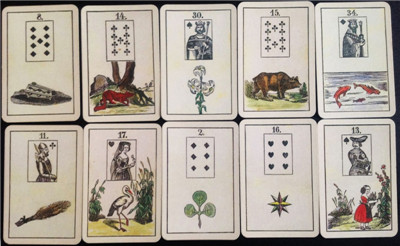"Etteilla was one of the people who actually made divination so esoteric," says Matthews. “He created a deck that incorporated all the things from Court de Gébelin and his book ‘Le Monde Primitif' ['The Primitive World'], which suggested an Egyptian origin for the tarot and all sorts of arcane things."Matthews makes a distinction between the tarot's abstract interpretations and the straightforward 'cartomantic'reading style that thrived during the 16th and 17th centuries, prior to Etteilla.
“像Alliette這樣的人將占卜變得更加神秘化,”Matthews說,“他的牌里吸收了Court de Gébelin的書《Le Monde Primitif(世界始源)》里所有的內(nèi)容,包括塔羅牌起源于埃及和其他神秘的東西。”Matthews對于十六到十七世紀時早于“艾特拉”的塔羅牌占卜中“抽象解讀”和“直接解讀”這兩種方法進行了區(qū)分。
"When we used to send telegrams, each word costs money,"Matthews explains, "so you'd have to send very few words like, ‘Big baby. Mother well. Come to hospital.' And you'd get the gist of it. I read cards in a very similar way—starting from a few general keywords and making sense of them by filling in the words that are missing. This isn't the tarot style of reading where you project things, like, 'I can see that you've recently had a great disappointment. Mercury is in retrograde and da da da.' A cartomantic reading is much more straightforward and pragmatic, for example, ‘Your wife will eat tomatoes and fall off the roof and die horribly.' It's a direct way of reading, a pre-New Age way of reading."
“我們以前發(fā)電報時,每一個單獨的字都是要花錢的,”Matthews解釋,“所以你說的話得盡量短比如,‘母將到院,親',從這幾個字里你就可以找到要點。我的塔羅牌解讀方法是很簡單的,找到幾個關鍵字,再把中間缺少的部分補上組成一個完整的句子。這和那種需要察言觀色的占卜術不同,比如‘我發(fā)現(xiàn)你今天很沮喪,你的水星軌道正在倒退'之類。相比之下我的方法更加直接和實用,得到的結(jié)果會是‘你妻子將會在吃番茄后從屋頂?shù)粝滤赖?#39;這樣直接的解讀,這是新世紀的占卜形式。”

One of Matthews'favorite decks is the Lenormand published by Bernd A. Mertz in 2004 based on a design circa 1840. Photo courtesy Caitlín Matthews.
Matthews最喜歡的一套牌,由Bernd A. Mertz在2004年印制,基于1840年的版本。













